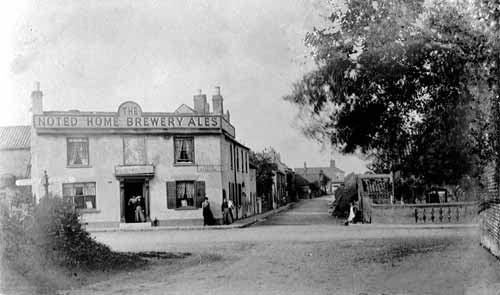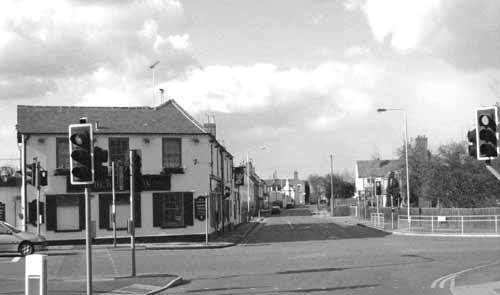![]()
The White Lion from Tithby Road

c.1900

2003
The most striking difference in this comparison of photographs taken 100 years apart is the change to the road layout. Fairfield Street has been more than doubled in width and the hedge and signpost, bottom left in 1900, has disappeared under the traffic island and filter lane from Tithby Road into the Nottingham Road. The signpost points left to, ‘Nottingham 9½, Radcliffe 3’ miles and right, ‘Grantham 14’ and, although difficult to read, probably ‘Whatton in the Vale – 3’ miles. The alterations in the road layout were carried out in 1960 and involved the demolition of the corner cottage, the house of the Sexton, Edmund Derry Smith, that can be glimpsed through the tree growing in the grounds of No. 2 Long Acre. The late 1940s’s house at No.2 Fairfield Street is named ‘Edmunderry’ to commemorate the Sexton. The wall of No.2 Long Acre was also re-aligned, and the tree removed, at the time of the road widening to give a safer corner. The only remaining Victorian post-box in Bingham was retained and set into the new wall.
The White Lion has also undergone considerable changes but those seen from this viewpoint are largely cosmetic; the basic structure remains the same, although, a large, flat roof extension has been added to the left. This can just be seen at the extreme left in the 2003 picture. The most noticeable change is that the roof advertising boards of c.1900 announcing, ‘The Noted Home Brewery Ales’, have been removed and the roof has been re-slated at the same time that the majority of the chimney stacks were removed c.1970. The main entrance onto Nottingham Road has been moved round the corner into Fairfield Street and has been replaced by a window. The sign above the original doorway reads, ‘John Banforth licensed retailer of spirituous liquors, ale, porter, beer and tobacco’. The other small sign on the corner reads, ‘good stabling’. No reference to John Banforth has yet been found in directories of the period. The new Fairfield Street entrance was originally a gated, arched dray cart entrance that can be seen in the c.1900 photograph. Matching sash windows have been installed including the ‘non-standard’ window frame seen to the left of the old entrance. Also, the pub sign above has been removed and replaced by a fifth sash window. Of all the conversions of period buildings in Bingham, this one is unique in that reproduction wooden shutters have been included on the ground floor windows. A new hanging sign is now on the Fairfield Street façade where the original window openings have mostly been retained.
The small cottage that adjoins the north end of the
pub, No. 1 Fairfield Street, is still there and the larger gap between
this and the next cottage, No.9, can be seen in the 2003 picture. A double
fronted house and four small terraced cottages were demolished in 1956
to form the White Lion car park and build two semi-detached houses set
back from the
road.
The c.1900 photograph gives a rather oblique view of the remaining cottages
on the western side of Fairfield Street. It is interesting to compare
this with the view in the opposite
direction from Kirkland House.
At the end of Fairfield Street, both Kirkland House and what is now ‘The Anchorage’, are both clearly visible. In 1900 Kirkland House was a shop. The postcard, dated ‘Dec 1903’, mentions buying milk there earlier that year. In a 1908 photo the wall sign is painted out and three lads pose outside. At this time the house had been purchased by James Walker and became the Workhouse Childrens’ Home. There is a corner doorway and windows on either side. The window onto School Lane can be seen in the 1900 postcard but it has since been bricked up. The window above and the chimney stack are unchanged.
